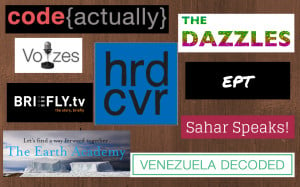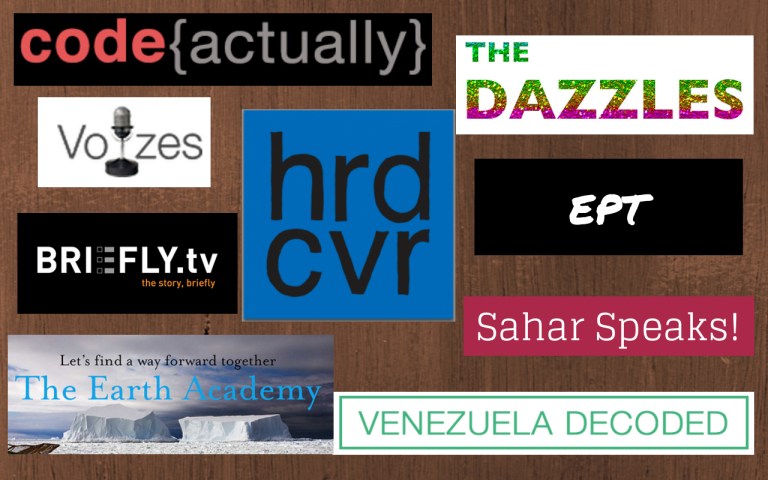“Journalism is dying.”
That is the response of many when I say I’m pursuing a graduate degree and career in journalism. With local newspapers closing every day, more and more people absorbing news through Twitter and Facebook and a drought in the hiring of journalists of color, they may be right—or so they think.

On Monday night at Stanford, this was the underlying mission of the 20 fellows who presented their visions for what journalism is and will look like moving forward. They have spent the past year, while taking breaks from their professional jobs, developing concepts and prototypes that will push journalism forward.
Here is a list of the most interesting and promising presentations:
The Top Seven (in reverse order)
7. Sahar Speaks! – All too often, news is told about a particular group of people or issue, not by those experiencing it, but by onlookers. Amie Ferris-Rotman wants to change this, specifically for females in Afghanistan. Her hope is to empower them with training, mentoring and an international publishing platform so that their stories, from their unique perspective, are told.
6. OpenFilter – Social media and misinformation go hand-in-hand in this age, unfortunately. In an effort to filter through the foolishness, Martin Quiroga and his team have developed a solution inVenezuela Decoded, a website that helps people “decode” the uprisings in Venezuela by synthesizing content from credible sources on Twitter. Having received international praise for this venture, OpenFilter is Quiroga’s way of open-sourcing the filtering platform his team has created.
5. Briefly.tv – According to Umbreen Bhatti, many journalists say they don’t cover legal stories because they’re too complicated and, except for at a courthouse, few can be found who want to cover such stories. In response, she has created a tool for television journalists that “does some of the work for them,” interviewing potential sources for a database-like platform that helps journalists cut through the barriers and tell stories regarding the legal system.
4. Code{actually} – Everyone from Mark Zuckerberg to President Barack Obama are on the coding and computer science train, and journalists are right behind them. The problem is, no one wants to meet us where we are—often a story-driven place, not a data-driven one. Cindy Royal knows our pain and has created a Code Academy for journalists, from a journalistic perspective.
3. The Dazzles – Every journalist wants a Pulitzer Prize. The problem, though, is that many people who get into journalism want to change the world and have an influence on people through their writing—and a Pulitzer is far from their mind. But each year, as the nominees and winners are announced, whichever pieces the proverbial “industry” deems the best receive the recognition—making a difference rarely plays a role in the criteria. The Dazzles are Shazna Nessa’s way of allowing readers to help decide what is good journalism. The goal is to allow journalists to know what resonates with our audiences so that we may better serve them.
2. The Earth Academy – “Not a leap, just a few steps away.” This is how Camille Seaman describes how we can curb climate change. Her project aims to become a hub for useful and empowering ideas for those who wish to make changes in their lives that are not difficult to adopt. An effort that also plans to create “hyperlocal villages of the future,” the plan is to “save ourselves and future generations yet unborn.”
1. hrdcvr – What can be more innovative than reimagining what print can look like—in print? “A new new, for the new everyone,” is how Danyel Smith describes her venture to create a concept magazine in the form of a book, “an extreme print experience.” A crowd-funded, one-time published product, she wants to “reject the niche” and “reject mainstream” because “it’s about the multi-stream.” Passion dripped from her eyes as she teared up at the notion that “everyone is equally interesting.” In my opinion, hrdcvr is poised to revolutionize what we have come to know as journalism and what we call print.
Honorable Mentions – These ideas didn’t make my top seven, but demonstrate the innovation needed to shake things up journalistically.
Voyz.es – Pitched by Ana Maria Carrano, this is a platform that aims to allow journalists and citizens to record and share audio—“think document cloud for voices,” she said. After speaking with more than 50 journalists who said they transcribed up to 10 interviews a week (each one taking up to two hours), she wanted to capitalize on the pieces of the interviews that don’t make it to print. Voyz.es is set to be a solution for journalists looking for stories to tell. In Carrano’s words, “Your conversations deserve a place to be found.”
Emergency Publishing Toolkit – After his experience in Manhattan in the wake of Hurricane Sandy, Andrew Losowsky wanted to know why little information was being passed around about what was going on or when the power would return. He set out to create a low-tech solution that would allow people to distribute news and information after city-rocking events such as natural disasters. The Emergency Publishing Toolkit was then born, a plastic bin filled with situation-specific approaches for spread information.
For information on the other presentations, visit the Knight Fellowship website.
This post was originally published on thedishdaily.com before it was acquired by The Stanford Daily in summer 2014.
